Potrebujeme váš súhlas na využitie jednotlivých dát, aby sa vám okrem iného mohli ukazovať informácie týkajúce sa vašich záujmov. Súhlas udelíte kliknutím na tlačidlo „OK“.
ASTM E2197-11
Standard Quantitative Disk Carrier Test Method for Determining the Bactericidal, Virucidal, Fungicidal, Mycobactericidal and Sporicidal Activities of Liquid Chemical Germicides
Automaticky preložený názov:
Štandardné Kvantitatívne Disk Carrier Skúšobná metóda na stanovenie baktericídne, virucídny, fungicídny, Mykobakteriocidný a sporicidní Činnosť kvapalných chemických dezinfekčné
NORMA vydaná dňa 1.1.2011
Informácie o norme:
Označenie normy: ASTM E2197-11
Poznámka: NEPLATNÁ
Dátum vydania normy: 1.1.2011
Kód tovaru: NS-44627
Počet strán: 13
Približná hmotnosť: 39 g (0.09 libier)
Krajina: Americká technická norma
Kategória: Technické normy ASTM
Kategórie - podobné normy:
Anotácia textu normy ASTM E2197-11 :
Keywords:
Adenovirus, Bacillus subtilis spores, bactericides, cell cultures, chemical germicides, Clostridium sporogenes spores, eluate, eluent, environmental surfaces, fungicides, hepatitis A virus, medical devices, membrane filtration, mycobactericides, Mycobacterium terrae, Pseudomonas aeruginosa, quantitative carrier test, rhinovirus, rotavirus, soil load, sporicides, Staphylococcus aureus, standard hard water, surrogate, Trichophyton mentagrophytes conidia, virucides, viruses
Doplňujúce informácie
| Significance and Use | ||||||||
|
The design of this test eliminates any loss of viable organisms through wash off, thus making it possible to produce statistically valid data using many fewer test carriers than needed for methods based on simple MPN estimates. The stringency in the test is provided by the use of a soil load, the microtopography of the brushed stainless steel carrier surface, and the smaller ratio of test substance to surface area typical for many disinfectant applications. Thus, the test substance being assessed is presented with a reasonable challenge while allowing for efficient recovery of the test organisms from the inoculated carriers. The metal disks in the basic test are also compatible with a wide variety of actives. The design of the carriers makes it possible to place onto each a precisely measured volume of the test organism (10 μL) as well as the control fluid or test substance (50 μL). The inoculum is placed at the center of each disk whereas the volumes of the test substance covers nearly the entire disk surface, thus virtually eliminating the risk of any organisms remaining unexposed. In all tests, other than those against viruses, the addition of 10 mL of an eluent/diluent gives a 1:200 dilution of the test substance immediately at the end of the contact time. While this step in itself may be sufficient to arrest the microbicidal activity of most actives, the test protocol permits the addition of a specific neutralizer to the eluent/diluent, if required. Except for viruses, the membrane filtration step also allows processing of the entire eluate from the test carriers and, therefore, the capture and subsequent detection of even low numbers of viable organisms that may be present. Subsequent rinsing of the membrane filters with saline also reduces the risk of carrying any inhibitory residues over to the recovery medium. Validation of the process of neutralization of the test substance is required by challenge with low numbers of the test organism. In tests against viruses, addition of 1 mL of buffer at the end of the contact time achieves a 1:20 dilution of the test substance while keeping the volume of the eluate reasonably small to allow for the titration of most or all of the eluate in cell cultures. Confirmation of neutralization of the test substance is required by challenge of a residual disinfection load with low numbers of infective units of the test virus. Since the virus assay system is indirect, an additional step is required to demonstrate that prior exposure of the appropriate cell line to any residual disinfectant or disinfectant/neutralizer mixture does not interfere with the detection of a low level of virus challenge (See Appendix). Note 1—In 5.5 and 5.6, volumes of 10 mL and 1 mL are recommended instead of 9.95 mL and 950 μL, respectively, for ease of dispensing the eluent. The soil load in this test is a mixture of three types of proteins (high molecular weight proteins, low molecular weight peptides, and mucous material) designed to represent body secretions, excretions, or other extraneous substances that microbicidal chemicals may encounter under field conditions. It is suitable for working with all types of test organisms included here. The components of the soil load are readily available and subject to much less variability than animal sera. If distilled water or other diluent is not to be specified on the product label, the diluent for the test substance is assumed to be tap water. Since the quality of tap water varies considerably both geographically and temporally, this test method incorporates the use of water with a specified and documented level of hardness to prepare use-dilutions of test substance that require dilution in water before use. While water with a hardness of at least 300 ppm as CaCO3 is recommended consult local regulations regarding use of hard water prior to testing. The Annex contains a list of those organisms that are often used in assessing the microbicidal activities of disinfectants for use on environmental surfaces or medical devices. Culture conditions for each organism are also included in the Annex. Depending on the label claim(s) desired and the requirements of the target regulatory agency, one or more of the organisms listed may be selected for the testing. If organisms other than those listed are to be used (for example, in the dairy or brewing industries), a clear justification must be provided and details of the culture media and growth conditions must be validated and clearly specified in test reports. |
||||||||
| 1. Scope | ||||||||
|
1.1 This test method is designed to evaluate the ability of test substances to inactivate vegetative bacteria, viruses, fungi, mycobacteria, and bacterial spores (1-7) on disk carriers of brushed stainless steel that represent hard, nonporous environmental surfaces and medical devices. It is also designed to have survivors that can be compared to the mean of no less than three control carriers to determine if the performance standard has been met. For proper statistical evaluation of the results, the number of viable organisms in the test inoculum should be sufficiently high to take into account both the performance standard and the experimental variations in the results. 1.2 The test protocol does not include any wiping or rubbing action. It is, therefore, not designed for testing wipes. 1.3 This test method should be performed by persons with training in microbiology in facilities designed and equipped for work with infectious agents at the appropriate biosafety level (8). 1.4 It is the responsibility of the investigator to determine whether Good Laboratory Practice Regulations (GLPs) are required and to follow them where appropriate (40 CFR, Part 160 for EPA submissions and 21 CFR, Part 58 for FDA submissions). 1.5 In this test method, SI units are used for all applications, except for distance in which case inches are used and metric units follow. 1.6 This standard does not purport to address all of the safety concerns, if any, associated with its use. It is the responsibility of the user of this standard to establish appropriate safety and health practices and determine the applicability of regulatory limitations prior to use. |
||||||||
| 2. Referenced Documents | ||||||||
|
Podobné normy:
Historická
1.4.2012
Historická
1.8.2012
Historická
1.10.2013
Historická
1.10.2009
Historická
1.10.2007
Historická
1.4.2011
Odporúčame:
Aktualizácia technických noriem
Chcete mať istotu, že používate len platné technické normy?
Ponúkame Vám riešenie, ktoré Vám zaistí mesačný prehľad o aktuálnosti noriem, ktoré používate.
Chcete vedieť viac informácií ? Pozrite sa na túto stránku.


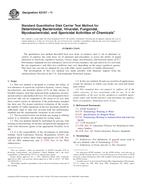
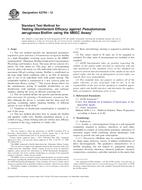 ASTM E2799-12
ASTM E2799-12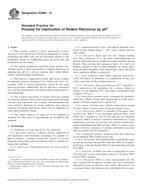 ASTM E2888-12
ASTM E2888-12 ASTM E2894-13
ASTM E2894-13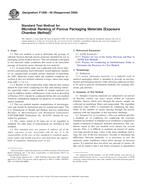 ASTM F1608-00(2009)..
ASTM F1608-00(2009)..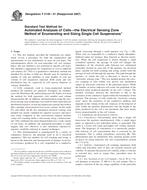 ASTM F2149-01(2007)..
ASTM F2149-01(2007)..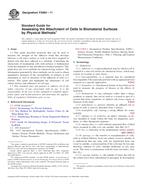 ASTM F2664-11
ASTM F2664-11
 Cookies
Cookies
